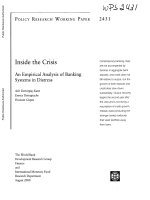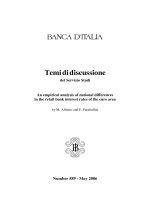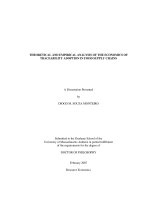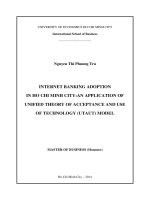Empirical analysis of internet banking adoption
Bạn đang xem bản rút gọn của tài liệu. Xem và tải ngay bản đầy đủ của tài liệu tại đây (1.11 MB, 125 trang )
MINISTRY OF EDUCATION AND TRAINING
UNIVERSITY OF ECONOMICS HO CHI MINH CITY
------------
HUYNH MINH SU
EMPIRICAL ANALYSIS OF
INTERNET BANKING ADOPTION
MASTER THESIS OF BUSINESS ADMINISTRATION
HO CHI MINH CITY - 2013
MINISTRY OF EDUCATION AND TRAINING
UNIVERSITY OF ECONOMICS HO CHI MINH CITY
------------
HUYNH MINH SU
EMPIRICAL ANALYSIS OF
INTERNET BANKING ADOPTION
Subject: Master of Business Administration
Code: 60.34.01.02
MASTER THESIS OF BUSINESS ADMINISTRATION
SUPERVISOR:
PhD. PHAM QUOC HUNG
HO CHI MINH CITY - 2013
I
ACKNOWLEDGEMENT
For the successful completion of this thesis, I would like to extend my
sincere thanks to:
Respectful lecturers of University of Economics Ho Chi Minh City,
who have empowered me with useful knowledge during the time I studied at
the eMBA course, especially PhD. Pham Quoc Hung, who have
enthusiastically instructed me to approach relevant problems in reality,
research methods, as well as the contents of the thesis.
Students of many universities, especially University of Economics Ho
Chi Minh City, customers of many banks in Vietnam, especially BIDV and
Sacombank, and all my friends, especially eMBA class for kindly helping me
to collect information necessary for the study. My special thanks also go to
Mr. Dang Huu Phuc for his strong support in the implementation of the data
analysis and the completion of the thesis.
Though the author has tried the best to complete the thesis, errors could
not be completely avoided. Consequently, the author is looking forward to
receiving the contributions and comments from respectful lecturers and
friends.
Huynh Minh Su
Ho Chi Minh, 19 September 2013
II
COMMITMENT
I would like to commit that this thesis, “Empirical of online banking
adoption”, was accomplished based on my independent and serious researchs.
The data was collected in reality and has obvious origins. Moreover, the data
was trustworthily handled by author.
I certify that any help hand received in preparing this thesis and all the
sources that used have been acknowledged.
Ho Chi Minh, 19 September 2013
Huynh Minh Su
Signature: _____________________
III
TABLE OF CONTENTS
ACKNOWLEDGEMENT................................................................................................... I
COMMITMENT................................................................................................................. II
TABLE OF CONTENTS ................................................................................................. III
LIST OF TABLES ............................................................................................................ VI
LIST OF FIGURES ....................................................................................................... VIII
ABSTRACT.......................................................................................................................... 1
CHAPTER 1 ......................................................................................................................... 2
INTRODUCTION ............................................................................................................... 2
1.1 Overview...................................................................................................................... 2
1.2 The research approach ................................................................................................. 2
1.3 Background of the study .............................................................................................. 3
1.4 Motivation of the study ................................................................................................ 4
1.5 Objective of the study .................................................................................................. 4
1.6 Problem discussion ...................................................................................................... 5
1.6.1 Problem definition ................................................................................................ 5
1.7 Research question ........................................................................................................ 6
1.8 Practical and theoretical value of this research ............................................................ 6
1.9 Structure of the study ................................................................................................... 7
CHAPTER 2 ......................................................................................................................... 9
LITERATURE REVIEW ................................................................................................... 9
2.1 Internet banking ........................................................................................................... 9
2.1.1 Conception of internet banking............................................................................. 9
2.1.2 Benefits of internet banking ................................................................................ 10
2.1.2.1 Benefits for banks ........................................................................................ 10
2.1.2.2 Benefits for customers ................................................................................. 11
2.1.3 International studies of consumer adoption of internet banking......................... 12
2.2 Adoption .................................................................................................................... 30
2.3 Theoretical framework............................................................................................... 31
2.3.1 Technology acceptance model (TAM) ............................................................... 31
IV
2.4 Trust and TAM .......................................................................................................... 31
2.5 Research model .......................................................................................................... 32
2.6 Summary .................................................................................................................... 36
CHAPTER 3 ....................................................................................................................... 37
METHODOLOGY ............................................................................................................ 37
3.1 Research purpose ....................................................................................................... 37
3.2 Questionnaire development ....................................................................................... 37
3.2.1 Independent variables ......................................................................................... 38
3.2.1.1 Perceived Benefit ......................................................................................... 38
3.2.1.2 Trust ............................................................................................................. 39
3.2.2 Dependent variable: Intention to Use / Reuse Internet banking ......................... 39
3.2.3 Moderator variable: Internet Experience ............................................................ 40
3.3 Questionnaire translation ........................................................................................... 42
3.4 Research strategy ....................................................................................................... 43
3.5 Targeted population ................................................................................................... 44
3.6 Research sampling ..................................................................................................... 45
3.6.1 Sample size ......................................................................................................... 45
3.6.2 Selecting the sampling technique ....................................................................... 45
3.7 Data collection ........................................................................................................... 46
3.8 Methods of data analysis............................................................................................ 46
3.8.1 Data screening..................................................................................................... 47
3.8.2 Reliability assessment of measurement scales (Cronbach alpha) ....................... 47
3.8.3 Validity assessment of measurement scales (EFA) ............................................ 47
3.8.4 Correlation Analysis ........................................................................................... 48
3.8.5 Multiple Regression (MR) .................................................................................. 48
3.9 Research process ........................................................................................................ 49
3.10 Summary .................................................................................................................. 51
CHAPTER 4 ....................................................................................................................... 52
DATA ANALYSIS ............................................................................................................. 52
4.1 Descriptions of sample............................................................................................... 52
4.2 Reliability and validity of the measurement scale ..................................................... 53
V
4.2.1 Reliability (Cronbach alpha) ............................................................................... 53
4.2.2 Exploratory factor analysis (EFA) ...................................................................... 55
4.2.2.1 EFA implementation for independent variables .......................................... 57
4.2.2.2 EFA implementation for dependent variable ............................................... 59
4.3 Testing the research model and the hypotheses ......................................................... 60
4.3.1 Testing correlations of constructs ....................................................................... 60
4.3.2 Checking regression assumptions ....................................................................... 62
4.3.3 Multiple regression analysis ............................................................................... 62
4.3.3.1 Testing the effects of Perceived Benefit (PB) and Trust (T) on Intention to
Use / Reuse (IU) ...................................................................................................... 62
4.3.3.2 Testing the moderating effects..................................................................... 66
4.4 Summary .................................................................................................................... 73
CHAPTER 5 ....................................................................................................................... 74
CONCLUSION .................................................................................................................. 74
5.1 Discussion .................................................................................................................. 74
5.2 Practical implication of the research .......................................................................... 76
5.3 Academic contributions of the study ......................................................................... 79
5.4 Limitation and futher research ................................................................................... 79
REFERENCES .................................................................................................................. 81
APPENDICES .................................................................................................................... 91
APPENDIX A ..................................................................................................................... 91
ACRONYMS ...................................................................................................................... 91
APPENDIX B ..................................................................................................................... 92
THE QUESTIONNAIRE .................................................................................................. 92
APPENDIX C ..................................................................................................................... 95
CRONBACH ALPHA ANALYSIS .................................................................................. 95
APPENDIX D ..................................................................................................................... 98
EXPLORATORY FACTOR ANALYSIS (EFA) ........................................................... 98
APPENDIX E ................................................................................................................... 109
GRAPHIC ANALYSIS OF REGRESSION ASSUMPTIONS.................................... 109
APPENDIX F ................................................................................................................... 112
MULTIPLE REGRESSION ANALYSIS (MR) ........................................................... 112
VI
LIST OF TABLES
Table 2-1 International studies on internet banking adoption ..................................13
Table 3-1 Survey items used in the study.................................................................41
Table 3-2 Relevant situation for different research strategies..................................43
Table 3-3 Summary ..................................................................................................44
Table 4-1 Demographic characteristics ....................................................................53
Table 4-2 Cronbach alpha coefficients .....................................................................54
Table 4-3 Details of the unqualified observation variable .......................................58
Table 4-4 EFA results of independent and dependent variables ..............................58
Table 4-5 Detail of the unqualified observation variable .........................................60
Table 4-6 Correlations ..............................................................................................61
Table 4-7 MR results using Enter technique ............................................................63
Table 4-8 ANOVA ...................................................................................................63
Table 4-9 MR variables coefficients ........................................................................64
Table 4-10 Results of hypothesis tests .....................................................................65
Table 4-11 MR having moderating effect results.....................................................67
Table 4-12 ANOVA having moderating effect results ............................................67
Table 4-13 MR variables coefficients having moderating effect results .................68
Table 4-14 MR results using Enter technique on case 1 (less than one year) ..........70
Table 4-15 ANOVA on case 1 (less than one year) .................................................70
Table 4-16 MR variables coefficients having moderating effect on case 1 (less than
one year) ....................................................................................................................70
VII
Table 4-17 MR having moderating effect results using Enter technique on case 2
(one year or longer) ...................................................................................................71
Table 4-18 ANOVA having moderating effect on case 2 (one year or longer) .......72
Table 4-19 MR variables coefficients having moderating effect on case 2 (one year
or longer) ...................................................................................................................72
VIII
LIST OF FIGURES
Figure 1-1 Structure of the Study ...............................................................................8
Figure 2-1 Proposed research model ........................................................................32
Figure 3-1 Research process ....................................................................................50
Figure 4-1 The research model 1 .............................................................................63
Figure 4-2 The research model 2 .............................................................................66
1
ABSTRACT
The thesis reports the findings of a study issues concerning the
adoption of Internet banking in Vietnam. This study investigates customers’
adoption within the context of Vietnam Internet Banking services and
research framework is based on the Technology Acceptance Model and Trust.
It should be noted that in the study, instead of using perceived usefulness, the
author utilize a new construct perceived benefit which is broader than
perceived usefulness.
Theory was developed to identify factors that would influence the
adoption of Internet banking. The framework includes Perceived Benefit,
Trust, and Intention to Use constructs. Futhermore, a moderator variable is
Internet Experience that adds to the model. Mutiple Regression (MR) was
used to examine the entire pattern.
Results shows that Perceived Benefit, and Trust were identified as two
important factors influencing the Internet banking adoption. Futhermore, the
relationship between Perceived Benefit and Intention to Use was found to be
significantly positive moderated by Internet Experience for respondents who
has Internet experience one year or longer. Theoretical contributions and
practical implications of findings are discussed and suggestions for future
research are presented.
2
CHAPTER 1
INTRODUCTION
The first chapter represents the research approach, background of the study,
motivation of the study, and presents the reader to the objective, problem research
question. Last of all, this chapter introduces contribution of the study and structure
of the thesis.
1.1 Overview
Advances in information and communication technologies such as the
growing use of the internet for business transaction, have an extreme effect on the
banking industry. While this is a global phenomenon, creating a global marketplace,
penetration of internet banking into developing countries moves slowly behind that
of the developed countries, specifically developed Western countries. Moreover,
poor economies, education and infrastructure are clear factors in the slow adoption
of technology in some developing countries. This thesis shows finding of research
into adoption of internet banking in Vietnam, a country of Southeast Asia.
1.2 The research approach
This research develops and tests a theoretical of the Technology Acceptance
Model (TAM) (Davis, 1989), and Trust, and examines the factors that influence the
adoption and acceptance of the information technology and system of the internet in
the banking sector in Vietnam, especially Internet banking.
A model, named Trust and TAM, has been previously presented in exploring
the acceptance of online shopping setting (Gefen et al, 2003). This model
integratively placed use of online system into both system features such as ease of
use and usefulness and trust in e-vendors.
3
It should be noted that in the study, instead of using perceived usefulness, the
author use a new construct perceived benefit which is broader than perceived
usefulness.
1.3 Background of the study
One of the most stunning aspects of the past few years has been the speed of
expanding and maturing of internet market. This rapid rate has opened up the
opportunities for marketers and created the pace of change in the marketing
landscape. (Wu, 2002).
The use of internet for business is easy to find in many industries. For
example, computer manufacturing companies such as IBM, Intel, Hewlet Packard,
etc… ; in the retail industry such as home shopping network,…; in the
pharmaceutical industry such as Du Pont,… ; in the aerospace industry such as
Boeing, ... (Eid, and Trueman, 2002).
It is obviously that the application of internet technologies to business for
improvements in their performances is common current trend. Bitner et al (2000)
state that technology continues to make a dramatic and profound impact in services
industries (Durkin, 2004). As stated by Saffu et al (2008), there is an increase in
applications of e-commerce in business in the past ten years (Chong et al., 2010).
The internet can currently be considered as the cheapest distribution channel
for standardized bank operations (Polasik, and Wisniewski, 2009). One e-commerce
tool that is being adopted by the banking industry is on line banking or e-banking
(Chong et al., 2010). Gurau (2002) shows that there are currently more than
thousands of e-banking web sites all over the world (Chong et al., 2010). As studied
by Chong et al., 2010, although online banking has been implemented in many
developed countries such as the United States and those in Europe (Pikkarainen et
al, 2004), there is a growing trend in the adoption of online banking by banks in
developing countries too (Gurau, 2002).
4
The ultimate success of e-commerce such as online banking is depending on
consumers’ perceptions and whether they are willing to use online banking (Chong
et al., 2010). According to Bruno (2003), from the point of view of the consumers,
the decision to use internet banking is frequently motivated by convience and
efficiency (Polasik, and Wisniewski, 2009).
Banking activities rely on information technology to acquire, process, and
deliver the information to all relevant users.
It is believed that, in the future, Internet banking will recede in importance as
a strategic application to become a competitive necessity that must be adopted by
most if not all banking and financial institutions.
1.4 Motivation of the study
The motivations for this research are as follows:
1. This is a new innovation in Vietnam. It is obviously that Internet
banking is a worldwide topic to study, so the quality of services in
Vietnamese banking sector can be enhanced for the future.
2. Internet banking has been widely studied in developed countries. Few
studies have been done in developing countries, especially in
Vietnam.
1.5 Objective of the study
The research points to enriching the knowledge and understanding of factors
affecting adoption of Internet banking services in Vietnam. Specifically, the main
objectives of this study are:
1. Investigate the adoption and use of Internet for banking transactions
by individuals in Vietnam as an example of a developing country.
2. Quantify constructs concerning the current state of consumer beliefs
and attitudes toward Internet banking.
5
3. Propose opportunities for both participants and researchers to uncover
unseen matters via improving the use and acceptance of Internet
banking.
4. Examine the moderating role in the theoretical model.
1.6 Problem discussion
Sekaran (2000, p.68) defined the problem statement as a “clear, precise and
succinct statement of the question or issues that is to be investigated with the goal
of finding an answer or solution” (Teh, 2006). This research aims to study the
determinant factors in Internet banking adoption. Accordingly, the research problem
which needs to investigate is Internet banking adoption. Useful insights will be
provided with regard to market segmentation and strategies fostering the adoption
of Internet banking.
1.6.1 Problem definition
There are past literatures studied on the adoption of Internet banking. Many
of these studies have tended to focus on developed countries such as European
countries, or the United States (Pikkarainen et al, 2004). Otherwise, there is still
some studies concentrate on developing contries such as Vietnam (Chong et al.,
2010). Developing contries is different from developed contries that the economy is
still expanding in recents years and its e-commerce infrastructure is still less
developed (Chong et al., 2010).
The primary objective of this research is to identify the main factors
underlying the consumer’s decision to adopt the internet banking in developing
countries. The result from this study will allow banks to focus on the factors which
can increase to adopt Internet banking.
6
1.7 Research question
Emory and Cooper (1991) suggested that in order to address the research
problem, the researcher had to identify the specific questions for which data is
needed to be gathered in order to satisfactorily solve the research problem (The
2006).
This research is dealing with the lack of studies on internet banking in
Vietnam. This research solves the intention towards Internet banking usage. So
research questions of this study will be:
What are the factors influencing adoption of Internet banking by
Vietnamese customers?
What is the role of Internet experience in acceptance of Internet
banking?
1.8 Practical and theoretical value of this research
The need to understand what the factors are influencing the adoption of
Internet banking is important for managers, providers and researchers. It is clearly
that there will be some beneficial applications of this research to Vietnamese banks
and researchers in Vietnam. Some of these practical applications are as follows:
1. The acceptance of Internet banking is a new topic in Vietnam. So the
results of this study could be used to improve the banking sector, and
enhance the quality of Internet services in Vietnam for the future.
2. Doing investigation on technology acceptance could enrich the
research fields in Vietnam, providing a standard of research that could
receive wider recognition. Vietnamese research organizations are
looking for guidance in creativity and innovation.
3. Helping bank managers to identify factors that influence the adoption
of Internet banking in order to increase the use of the services.
7
1.9 Structure of the study
This thesis is organized into 5 chapters as shown in Figure 1-1.
Chapter 1: Introduction
The first chapter represents the research approach, background of the study,
motivation of the study, and presents the reader to the objective, problem research
question. Last of all, this chapter introduces contribution of the study and structure
of the thesis.
Chapter 2: Literature review
Chapter two is structured along several themes. First of all, this chapter
explains the basic terminology of Internet banking. Second, this chapter outlines the
definition of adoption. Third, different intention based models introduced. Finally,
the chapter concludes by research model and hypotheses.
Chapter 3: Methodology
This chapter discusses the research methodology of the thesis. It starts with
research purpose and questionnaire development. It also outlines questionnaire
translation, research strategy and targeted population. Finally it presents research
sampling, data collection, methods of data analysis, and research process.
Chapter 4: Data analysis
In this chapter the author will analyze the data related to the evaluation of
measurement scales, research model and hypotheses. The content of the Chapter
includes: description of sample, assessing the reliability and the validity of scale
through Cronbach alpha coefficients and Exploratory Factor Analysis (EFA)
method, testing the research model and hypotheses with correlation analysis and
multi linear regression analysis. SPSS software version 16.0 was the tool using for
this data analyzing process.
Chapter 5: Conclusion
8
Based on the result obtained in the study, a discussion of theoretical and
practical implication will be presented on this chapter. Futhermore, the author will
also have some recommendations for banks. Contribution of this study, its
limitations and future research also will be presented in this chapter
Chapter 1
Introduction
Chapter 2
Literature Review
Chapter 3
Methodology
Chapter 4
Data Analysis
Chapter 5
Conclusion
Figure 1-1 Structure of the Study
9
CHAPTER 2
LITERATURE REVIEW
Chapter two is structured along several themes. First of all, this chapter
explains the basic terminology of Internet banking. Second, this chapter outlines the
definition of adoption. Third, different intention based models introduced. Finally,
the chapter concludes by research model and hypotheses.
2.1 Internet banking
2.1.1 Conception of internet banking
Today many organizations implement e-business as well as an important part
of business strategies. With the growth of the internet, banks now move towards
providing online banking for customers. The term “Internet banking” encompasses
a whole range of banking services, which can be accessed remotely with the use of
an internet browser (Polasik, and Wisniewski, 2009). Wang et al. (2003) describe
internet technologies has changed the way personal financial services (Chong et al.,
2010). Shin and Fang (2004) say internet banking like a new type of information
system that uses the innovative resources of the internet and world wide web
(www) to make customers possible to effect financial activities in virtual space
(Chong et al., 2010).
Through the development of asynchronous and secured electronic
transactional technologies, banks are now using online banking both a tracsactional
and an informational medium. According to Chong et al., 2010, registered internet
bankings users can now perform common banking transactions such as writing
cheques, paying bills, transferring funds, printing statements, setting up fixed
deposits, purchasing investment related funds and enquring about account balances.
Tan and Teo (2000) state that internet banking has involved into a “one stop service
10
and information unit” that promises greate benefits to both banks and consumers
(Chong et al., 2010).
Duclaux (1996) and Liao et al (1999) describe the market for internet
banking is forecasted to grow sharply in the next few years, affecting the
competitive advantage enjoyed by traditional banks with physical branches (Chong
et al., 2010).
2.1.2 Benefits of internet banking
2.1.2.1 Benefits for banks
Internet banking can bring about various benefits for banks and their
customers. Cost savings, efficiency, gaining new segments of customers,
improvement of the bank’s reputation and better customer services and satisfaction
are primary benefits to banks (Jayawardhena and Foley, 2000). Booz-Allen and
Hamilton (1997) argue, based on their global survey, that setting up a specialized
Internet banking infrastructure costs about US$1-2 million, which is much lower
than setting up a banking branch. Moreover, the authors conclude that costs for
running a traditional bank account for 50% to 60% of its revenues.
Under the view of Robinson (2000), relevant costs for conducting a banking
transaction via online are much lower than via a brick and mortar branch. In
addition, Sheshunoff (2000) contends that one of the most important factors
influencing the adoption of Internet banking by banks is the need to build up strong
barriers to customer exiting. Under the view of the author, once customers become
familiar with the utilization of full service Internet banking, it is unlikely that they
will change to another financial institution. Such an argument can be supported by
the consumer behavior theory that switching costs are often very high in terms of
time and efforts by consumers. Finally, the author emphasizes that the
implementation of Internet banking can bring about many competitive advantages
for banks in today’s highly competitive banking market.
11
Research on Internet banking has been carried out in Denmark by Mols
(1998). The author argues that Internet banking can play an important role in
enhancing cross-selling and price differentiation. Internet banking can make
favorable conditions for banks to provide customers numerous services 24 hours a
day and 7 days a week. Internet banking can improve customer satisfaction with the
bank due to the fact that it makes customers less price sensitive, and improves their
intention to repurchase, and more loyalty to the bank via providing more positive
words of mouth about the bank than other bank customers.
2.1.2.2 Benefits for customers
It should be noted that Internet banking not only brings about benefits to
banks but also to their customers. Thanks to the emergence of the Internet, banking
transactions are no longer limited to time and geography. It is very easy for
consumers throughout the world to access to their bank accounts 24 hours per day
and seven days a week. Customers can enjoy a variety of services, especially
services which are not provided by traditional bank branches. It is argued that one
or the greatest benefits that Internet banking brings about is that it is not expensive
or may even be free for customers to utilize Internet banking products or services.
However, some people believe that prices appear to be one factor that is
impedimental to the diffusion of Internet banking (Sathye, 1999). The price debates
often revolve around geographical differences and disparities between costs of
Internet connections and telephone call pricing.
It has also been believed that Internet banking have been changing to
respond to customers’ increasingly changing demands (Jun and Cai, 2001). There
has been a tendency that customers don’t want to travel to or from a bank branch to
conduct some banking transactions. In other words, they want to utilize Internet
banking to save time and money. Internet banking can bring about convenience and
accessibility, and have positive effects on customer satisfaction and loyalty
(Karjauloto, Mattila, and Pento, 2002). It is possible for customers to manage their
12
banking transactions whenever they want to enjoy improved privacy in their
interactions with the bank. Moreover, customers can enjoy more benefits at lower
cost levels by utilizing Internet banking (Mols, 1998).
It is contended by Turban et al. (2000) that Internet banking is really
beneficial to customers in terms of cost savings, no limit on time and space, quick
response to customers complaints, and better services or products. Such benefits are
believed to elevate customer satisfaction. Finally, it is obviously that Internet
banking offers many benefits to both banks and their customers.
2.1.3 International studies of consumer adoption of internet banking
The banking market plays an important role in human society nowadays.
This makes competition between each others banks. They want to have strong
effects on consumer behavior, so new banking technology is used most among
many ways to improve the competition of banks. That is the reason for banks
implementing internet banking services. However, it is required to better understand
their customers regarding attitudes of customers towards technology. This is the
vital factor which creates favorable conditions for banks to better impact on and to
determine consumer behavior. Impacting and determining consumer behavior in an
effective and efficient way will lead to make significant contribution to competitive
advantage for banks. It is worth noting that interactions between the adoption and
marketing of new electronic delivery channels through relationships between banks
and their customers have been establishing new environments in which customers
are better served (Mols, 1998). There is an important number of research in the
literature about the adoption process of internet banking services. The following are
noteworthy studies on the online banking adoption process.
13
Table 2-1 International studies on internet banking adoption
Authors
Name of study
Models
Determinants
Akhlaq, and
The effect of
TAM
+ Intrinsic
Ahmed, 2013
motivation on
Self-
+ Extrinsic
trust in the
determination
acceptance of
+ Trust
theory
internet banking
in a low income
country
Findings:
The authors show that acceptance of internet banking in a low-income country
merely depends on the intrinsic motivation factors such as perceived ease of use and
perceived enjoyment. Furthermore, trust plays an important role in the acceptance
of internet banking and is provoked in an individual through intrinsic motivational
factors.
Authors
Name of study
Models
Determinants
Giovanis, Binioris,
An extension of
and
TAM model with The innovation + Perceived ease of use
IDT and
diffusion
+ Compatibility
security/privacy theory
+ Security and privacy
risk in the
risk
adoption of
Polychronopoulos,
2012
internet banking
services in
Greece
TAM
+ Perceived usefulness
+ IT experience
+ Age
+ Gender
14
+ Behavioural intention
Findings:
The study reveals that service compatibility is the key factor, which mostly shapes
customers’ behavioural intentions toward internet banking adoption, followed by
TAM constructs and perceived risk elements. Furthermore, TAM and perceived
security and privacy risk constructs partially mediate the relationship between
compatibility and customers’ behavioural intentions, whereas perceived usefulness
partially mediates the relationship between perceived ease of use and customers’
intentions.
Last of all, in terms of the impact of individual differences on customers’ beliefs
about internet banking compatibility, value and risk elements, younger, mostly male
customers, with adequate previous IT experience are a more promising target group
to use internet banking.
Authors
Name of study
Models
Determinants
Kesharwani, and
The impact of
TAM
+ Trust
Bisht, 2012
trust and
Diffusion of
+ Wesite design
perceived risk on
innovation
internet banking
+ Perceived behavioral
model
control
adoption in
India: an
+ Social influences
extension of
+ Perceived risk
technology
acceptance
model
+ Perceived ease of use
+ Perceived usefulness
+ Behavioral intention
Findings:
15
Based on the results of this study, perceived risk has a negative impact on
behavioral intention of internet banking adoption and trust has a negative impact on
perceived risk. Moreover, a well-designed website has significant impact on
facilitating easier use and also minimizing perceived risk concerns regarding
internet banking usage.
Authors
Name of study
Models
Determinants
Mansumitrchai, and
Factors
The diffusion
+ Difficulty
AL-Malkawi, 2011
underlying the
of innovation
+ Trust
adoption of
online banking
+ Compatibility
by Mexican
+ Third party concerns
consumers
+ Human contact
+ Reference group
influence
+ Security
+ PC skills
Findings:
The results from factor Analysis reveal that eight characteristics of the adoption,
such as difficulty, trust, compatibility, third party concerns, human contact, social
influence, security, and computer proficiency. Moreover, Analysis of Variance
shows that adopters and non-adopters differ on their attitudes toward four attributes
of the adoption, such as difficulty, trust, compatibility and human contact. In
addition, comparing the attitudes of adopters and non-adopters with the issues of
security and third party concerns, the study has no significant differences.
On the other hand, an interesting finding is that human contact is important for non-









